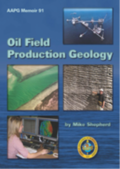Lithofacies maps
THIS PAGE IS IN PROCESS
| Oil Field Production Geology | |

| |
| Series | Memoir |
|---|---|
| Chapter | Lithofacies maps |
| Author | Mike Shepherd |
| Link | Web page |
| PDF file (requires access) | |
| Store | AAPG Store |
Lithofacies maps show the areal variation in the depositional patterns that make up each genetic sequence within the reservoir interval. The method for constructing lithofacies maps involves extrapolating the lithofacies from the wells into the gaps between the wells. This is not easy, as there will be mostly vertical or near vertical well data in the field. The vertical facies profile may be determined reasonably confidently; however, the lateral facies progression will have to be inferred by analog and other means.
Use of analogs for lithofacies mapping
The practice of making lithofacies maps with the help of modern analogs is an effective method for filling in the gaps in the subsurface (Galloway and Hobday, 1996). Modern analogs show the geometrical interrelationship of the various sedimentary bodies; they also permit the width and length of the various macroforms to be readily measured.
However, there are limitations to the use of modern analogs. Certain macroforms lack preservation potential and may not be common in the subsurface because of erosion. Conditions today may not be anything like the prevailing conditions when a given interval of reservoir sediments formed. The present day has a specific climate, tectonic variability, relative position of sea level, and rate of sea level change (Grammer et al., 2004). For example, the continents are mountainous and widely dispersed, with a tendency for shorelines to cut predominantly north–south across the world's climate zones. The Earth currently has ice caps but has lacked them for large parts of its geological history.
[[file:
Modern and ancient analogs can be investigated by referring to technical papers and outcrop studies, or the examination of aerial photographs (Tye, 2004). The latter is a particularly vivid source of information (Figure 69). Geologists working on carbonate reservoirs, for example, should have a look at the AAPG publication on modern day carbonate environments (Harris and Kowalik, 1994). The book includes a series of aerial photographs along with a transparent overlay giving the outlines of typical carbonate fields. This gives a very good impression of the size of depositional environments relative to the field scale. The photographs illustrate the fact that many depositional environments cover a much larger area than oil fields. This is an important observation. Because depositional environments extend over a greater area than the field, the geologist should investigate the sedimentology at the larger (basin) scale to get a realistic idea of the basinal controls influencing the sediments at the field scale.
Satellite photographs are available for consultation on the Internet; for example, Google Earth™. The site provides an easily accessible integrated network of satellite photographs spanning the globe. These can be examined at any scale. The program also provides a measuring tool, which allows sediment body dimensions to be readily derived. Table 1 provides a list of some potential reservoir analogs to look at on satellite photographs.
| Depositional Environment | Location | Latitude | Longitude |
|---|---|---|---|
| Desert dune field | Namibia | 24°49'27.07"S | 15°22'50.95"E |
| Barchan dunes | China | 39°51'13.70"N | 102°35'24.13"E |
| Sabkha lake | Tunisia | 33°41'28.31"N | 8°28'21.40"E |
| Alluvial fans | United States | 36°10'42.30"N | 116°54'12.46"E |
| Braided river | Madagascar | 21°45'32.20"S | 43°53'57.55"E |
| Braided river | New Zealand | 43°42'57.69"S | 171°57'56.03"E |
| Meander belt | Russia | 58°49'39.10"N | 81°30'57.08"E |
| Meander belt | Brazil | 6°55'21.12"S | 64°39'25.27"W |